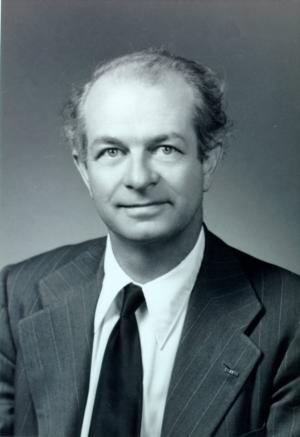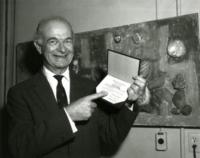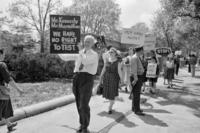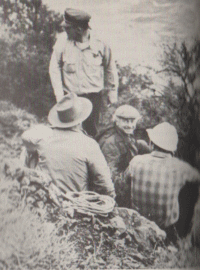 SKC Films Library SKC Films Library |
| SKC Films Library >> Science >> Chemistry >> Biography |
| Linus Pauling two-time Nobel Prize winner
Early Life and Education Linus Carl Pauling was born in Portland, Oregon, on February 28, 1901, the first of three children and only son of Herman Henry William (a druggist) and Lucy Isabelle (Darling) Pauling. He was nine years old when his father died, after which he withdrew into books and hobbies. His interest in chemistry began when he was 14, during a visit with a friend who owned a toy chemistry set. Entranced by the flames, smokes, odors, and by the sight of mysterious changes in solutions and powders, Pauling ran home and began assembling a rough "laboratory" in a corner of his basement. By age 16 Pauling had accumulated enough credits to enter Oregon Agricultural College, but was two American history courses short of qualifying for his high school diploma. Denied permission to take the courses concurrently during the spring semester, he dropped out of Washington High School in June 1917 and entered the college for the fall 1917 semester. [The high school awarded him a diploma 45 years later, after he had won two Nobel Prizes.] Pauling showing off his honorary high school
diploma While still an undergraduate Pauling was asked to teach chemistry courses, and he soon became known as a great lecturer and his classes were quite popular. One of his students was Ava Helen Miller, whom he married on June 17, 1923. The couple eventually had three sons, Linus Paul Jr., Peter, and Crellin, and a daughter, Linda. Post-Graduate Work By the time he graduated as a chemical engineer in 1922 Pauling had set his sights on answering one of the most important questions of chemistry -- how did atoms bond together to form molecules? In order to find out, he turned from chemical engineering to chemical theory and became one of the first chemistry students in a doctoral program at the California Institute of Technology (Caltech) designed and overseen by the famed chemist Arthur Amos Noyes. Noyes pointed Pauling in the direction of a new experimental technique called x-ray crystallography, which enabled scientists to learn about the sizes and configurations of atoms within molecules and crystals. Pauling earned his Ph.D. (summa cum laude) in 1925, and then spent 15 months in Europe on a Guggenheim Fellowship, intending to study the basics of atomic structure. Instead, he learned about quantum mechanics, and was one of the first to bring the discipline into the United States. Pauling returned to Caltech in 1927 as assistant professor of theoretical chemistry and began to apply quantum mechanics to problems of chemical structure and function. He became an associate professor in 1929 and a full professor in 1930. Early Work The first five years of Pauling's "professional career" were very productive, as he published about fifty papers related to his x-ray crystal studies and the use of quantum mechanics to investigate chemical structure and function. In 1929 he published a set of five rules for predicting and rationalizing the crystal structures of ionic compounds (now known as Pauling's Rules). In 1930, he and Samuel Goudsmit published Structure of Line Spectra, a book on the physics and the practice of spectroscopy. In 1931, the American Chemical Society awarded Pauling the Langmuir Prize for the most significant work in pure science by a person 30 years of age or younger. The following year he published a paper in which he first laid out the concept of hybridization of atomic orbitals. In 1932 he introduced the concept of electronegativity and established what is now called the Pauling Electronegativity Scale, which is useful in predicting the nature of bonds in molecules. In 1933 Pauling became the youngest person to that time to be elected a member of the National Academy of Sciences. In 1936 he was promoted to Chairman of the Division of Chemistry and Chemical Engineering at Caltech, and to the position of Director of the Gates and Crellin laboratories of Chemistry. [He would hold both positions until 1958.] His research on chemical bonds resulted in The Nature of the Chemical Bond and The Structure of Molecules and Crystals: An Introduction to Modern Structural Chemistry. Published in 1939, it remains Pauling's most important and path-breaking work. World War II Upon outbreak of the Second World War, Pauling offered both his laboratory and his services as a research consultant to the Defense Department. During the war he devised explosives and missile propellants for the Navy, invented a meter that monitored oxygen levels in submarines and airplanes, and, with an associate, developed a synthetic form of blood plasma for use in emergency transfusions in battlefield clinics. He also participated in a wartime presidential commission formed to recommend future directions of government-funded scientific and medical research programs. President Harry Truman recognized Pauling's work during the war by presenting him with the Presidential Medal for Merit in 1948. Post-War Work Pauling had started his structural studies with inorganic molecules, but during the 1930's he shifted his structural studies to large biomolecules, especially proteins. One of his first major studies in this field involved the structure of hemoglobin, and he was able to show that the hemoglobin molecule changes structure when it gains or loses an oxygen atom. This work led him into a study of protein structure in general. It took him over a decade to determine that the atoms in a protein molecule are arranged in a helical pattern. Although later researchers found a number of flaws in his work on proteins, his proposal that DNA was composed of two strands of proteins arranged in a triple helix pattern was essentially correct (it is actually a double helix pattern). In 1949, Pauling, Harvey Itano, S.J. Singer, and Ibert Wells published "Sickle Cell Anemia, a Molecular Disease" in the journal Science. The article contained the first proof of a human disease caused by an abnormal protein. Specifically, it showed that individuals with the disease had a genetically transmitted abnormality in the hemoglobin molecule that causes it to distort and stick to other molecules when oxygen is not present. His success with sickle cell anemia led Pauling to speculate that a number of other diseases, including mental illnesses such as schizophrenia, might result from flawed genetics. Pauling was also one of the first scientists to propose that antibody and antigen molecules work because they are "made to fit" into or onto another molecule in such a way as to interfere with the "host" molecule's normal properties. Pauling's many achievements were crowned with the awarding of the Nobel Prize for Chemistry in 1954, "for his research into the nature of the chemical bond and its application to the elucidation of the structure of complex substances." the Pauling family at the 1954 Nobel Prize
ceremony Activism Pauling's "career" as an activist began just after World War II ended. The destruction caused by the two atomic bombs dropped on Japan prompted many scientists, including Pauling, to publicly call for civilian oversight and limitations on nuclear testing. His outspokeness drew the ire of many in Washington, D.C., and the State Department went so far as to deny him a passport to travel to scientific conferences abroad. His passport was returned after he was named as the winner of the Nobel Prize for Chemistry. On July 9, 1955, Pauling joined Albert Einstein, Bertrand Russell, and eight other leading scientists and intellectuals for the issuance of a manifesto highlighting the dangers posed by nuclear weapons and calling on world leaders to seek peaceful resolutions to international conflicts. On January 15, 1958, Pauling and his wife presented an appeal for a nuclear test ban to the United Nations in the form of a petition signed by 9,235 scientists from 44 countries. On February 20, he participated in a televised debate with physicist Edward Teller about nuclear weapons testing and the dangers of nuclear fallout. Later that same year No More War!, in which he not only called for an end to the testing of nuclear weapons but also an end to war itself. He proposed that a World Peace Research Organization be set up as part of the United Nations to "attack the problem of preserving the peace." In 1960 Pauling was subpoenaed to testify about his anti-nuclear testing petition before the United States Senate Subcommittee on Internal Security. He appeared twice and was threatened with contempt for refusing to name those who helped him circulate the petition. Following publicity about the case, no contempt citation was issued. On April 29, 1962, Pauling and his wife led a protest against atmospheric nuclear testing outside the White House gates. That evening they sat down inside the White House, at an elegant dinner party hosted by President John F. Kennedy and his wife in honor of Nobel laureates. The Paulings even got up and danced when some lively music was played, much to the amusement of their hosts and other guests. Pauling marching in front of the
White House Pauling's anti-nuclear testing work was capped in the fall of 1963 with the Nobel Peace Prize for 1962 (a year in which no prize had been awarded). The award was presented on October 10, 1963, the same day that the Nuclear Test Ban Treaty went into effect. To date Pauling is the only person to ever win two unshared Nobel Prizes. He went on to become a prominent member of the anti-Vietnam War movement. Pauling showing off his Nobel Peace
Prize certificate Later Work Pauling's activist work led the Caltech Board of Trustees to demand Pauling's resignation as chairman of the Chemistry and Chemical Engineering Division in 1958. He was allowed to stay on as a fully tenured professor, but chose to resign from that position as well after receiving the Nobel Peace Prize. He spent the next three years at the Center for the Study of Democratic Institutions. He moved to the University of California at San Diego in 1967, and to Stanford University in 1969. While at San Diego and Stanford, Pauling examined published reports about vitamin C and concluded that, when taken in large enough quantities (megadoses), it could help the body fight off colds and other diseases. The outcome of his research was the book Vitamin C and the Common Cold (1970). The medical community criticized his decision to publish a popular book on the subject without prior peer-reviewed scientific publication, but Pauling refused to back down from his claims, in part because he had been personally managing Bright's Disease since 1941 with a low-protein salt-free diet and vitamin supplements. In 1973 he co-founded the Institute of Orthomolecular Medicine in Palo Alto, California (later moved to Oregon State University and renamed the Linus Pauling Institute of Science and Medicine). Despite all of his earlier accomplishments, very little of Pauling's later work was received with enthusiasm by the scientific community. In 1979 he and Scottish physician Ewan Cameron published Cancer and Vitamin C, in which they claimed that Vitamin C could be a useful tool in the fight against cancer. Their ideas were subjected to experimental animal studies funded by the institute. While these studies supported their ideas, investigations at the Mayo Clinic involving human cancer patients did not corroborate their results. In an effort to raise money to support his increasingly troubled institute, Pauling published How to Live Longer and Feel Better in 1986, but the book failed to become the success that he and his associates had anticipated. Despite their personal reliance upon megadoses of vitamin C, both Pauling and his wife developed cancer. Ava Helen died of stomach cancer in 1981. Linus Pauling died of prostate cancer at his Big Sur ranch on August 19, 1994. The money that Pauling received as a Nobel Prize for Chemistry winner allowed he and his wife to buy 160 acres of oceanfront land in the Big Sur region of California, and the couple turned it into a personal retreat they called Deer Flat Ranch. On the morning of January 30, 1960, Pauling went out for a walk, telling Ava Helen that he was going to check some fence lines. When he wasn't back by noon she began to worry; by early evening she was frightened and went to a nearby ranger station for help. A search was quickly organized, but it had to be halted at 11:30 p.m. An even larger search began the next morning, and he was finally found at about 10 a.m., perched precariously on a small ledge on the side of a cliff. He told his rescuers that he had slipped down the cliff the previous day and was too afraid of touching off a rockslide to attempt a climb back up. He had spent the night sitting as still as he could and forcing himself to stay awake. Ava Helen was greatly relieved upon learning that her husband had been found safe.
SOURCES SEE ALSO |
| SKC Films Library
>> Science >> Chemistry >> Biography This page was last updated on 06/02/2017. |



